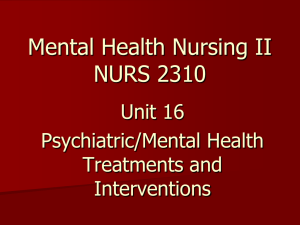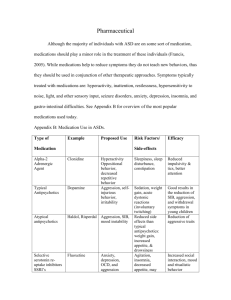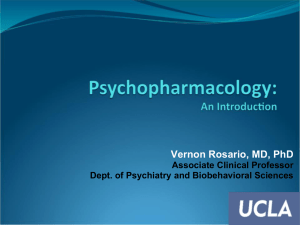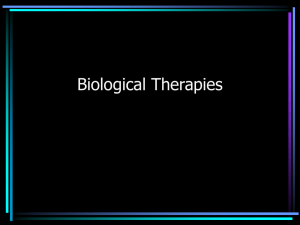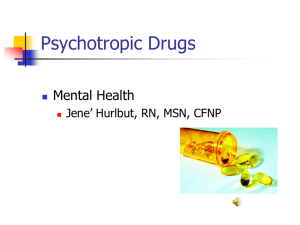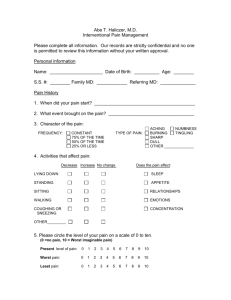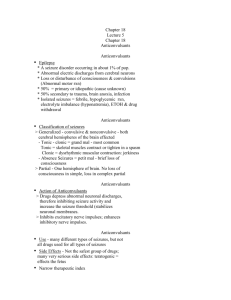psychopharmacology - International Association of Psychiatric
advertisement
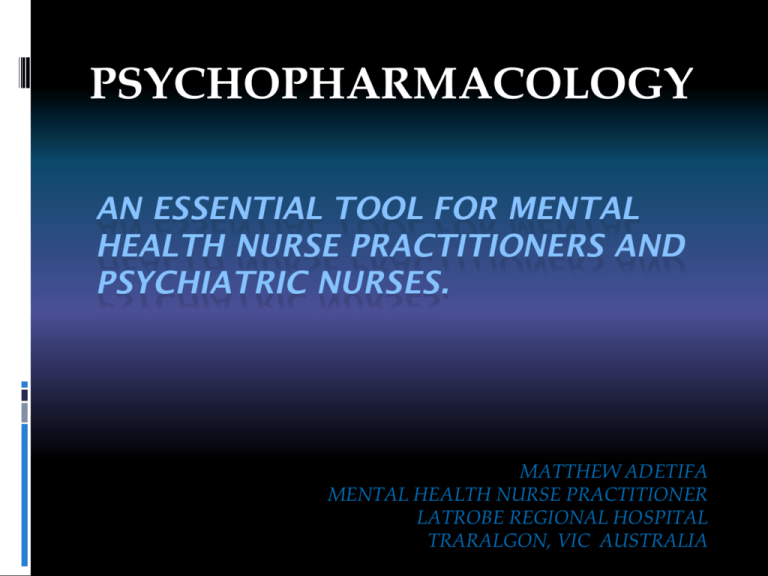
PSYCHOPHARMACOLOGY AN ESSENTIAL TOOL FOR MENTAL HEALTH NURSE PRACTITIONERS AND PSYCHIATRIC NURSES. MATTHEW ADETIFA MENTAL HEALTH NURSE PRACTITIONER LATROBE REGIONAL HOSPITAL TRARALGON, VIC AUSTRALIA OBJECTIVES What is Psychopharmacology? Principles of Psychopharmacology Neurobiology & Neurotransmitters Classes of psychotropic drugs Side effect, adverse effect & interventions • Drug-Drug interaction • Antidepressants • Psychoeducation • • • • • What is Psychopharmacology? Study of the use of medications in treating mental disorders. Involving Pharmacokinetics (what body does to medications) & Pharmacodynamics (what the medications do to the body) Principles of Psychopharmacology Therapeutic index: Drug’s margin of safety It is the ratio between the dose that produces the desired effect in 50 percent of the animals and the dose that produces toxic effects in 50 percent of the animals. Principles of Psychopharmacology Effects of Repeated Administration Tolerance a decrease in the effectiveness of a drug that is administered repeatedly Sensitization an increase in the effectiveness of a drug that is administered repeatedly Withdrawal Symptom Appearance of opposite symptoms produced by drugs used repeatedly when discontinued suddenly. Neurobiology Neurons Dendrites Axons Neurobiology II Synapse Neurotransmitter A chemical messenger that carries, boosts and modulates signals between neurons and other cells in the body Classical Neurotransmitters Type Groups: Classical Neurotransmitters ( 7 relevant in Psychophamacology) Neuropeptide Neurotransmitters. Neurotransmitt er Postsynaptic effect Acetylcholine Excitatory Amino Acids GABA Biogenic Amines Inhibitory Glycerine Inhibitory Glutamate Excitatory Aspartate Excitatory Dopamine Excitatory Noradrenaline Excitatory Serotonin Excitatory Histamine excitatory Neurotransmitters & Related Mental Disorders Neurotransmitters Mental disorder Decreased Norepinephrine Depression Decreased Serotonin Depression Decreased Acetylcholine Alzheimer’s Disease Decreased GABA Anxiety Increased Dopamine Schizophrenia Pharmacokinetics Absorption Route of administration: PO, IV , IM Frequency Individual condition like Age– Older Physical health condition CCF, GI Others --Exercise Pharmacokinetics Distribution Distribution is the foundation on which all therapeutic and toxic plasma drug concentrations are established . Affected by Target Tissue Cardiac Output: CCF, Chronic pulmonary disease and electrolyte imbalance Serum Protein binding Half life of the drug Pharmacokinetics Elimination Concept of plasma half-life A time measurement, which starts when the drug reach equilibrium (Fully Absorbed). It is the time it takes for the blood levels of drug to decrease top half of what it was at equilibrium. Distribution half life : plasma level fall due to distribution and storage in body reservoirs. Elimination half-life: plasma fall due metabolism and elimination Pharmacokinetics Elimination II Drugs are eliminated in metabolized or unmetabolized forms through : Kidneys—urine Intestines- faeces Lungs- exhaled breath Skin– Sweat Saliva, breast milk, bile (faeces), semen , tears etc. Elimination is slower in newborns & elderly Elimination may be faster in healthy children or teen than adults. Pharmacokinetics Metabolism This is how the body chemically changes a drug -- usually in the intestines and liver. CYP-450 enzyme system drug-drug interactions inhibitor cause increased drug level Inducer cause decreased drug level www.thebody.com Classes of Psychotropic medication Antipsychotic medications Antidepressant medications Mood-stabilizing drugs Anti-anxiety medications Psychostimulants Antipsychotics Typical Oldest antipsychotic chlorpromazine 1950 Mechanism- Block dopamine receptors Effective in treating positive symptoms & agitation Atypical Discovered in the 1980’s Targets dopamine & serotonin (works on (-) & (+) sx Better tolerated, impairment side effects, cognitive Antipsychotics Typical: Phenothiazine Non-Phenothiazine Differ in Potency, not effectiveness High : Haloperido l, Fluphenazine Mid Loxapine, Perphenazine Low Chlorpromazine Atypical Antipsychotics In Australia Olanzapine, Clozapine, Aripiprazole, Ziprasidone; Paliperidone, Asenapine (saphris) and Quetiapine. Long acting injectable: Risperdal consta, Paliperidone and Olanzapine Side effects of antipsychotics EPSEs Akathisia-Motor restlessness Dyskinesia- Jerky motion Dystonia – Muscle rigidity (life- threatening) Tardive dyskinesia—(irreversible) facial grimacing, tics, lip smacking Neuroleptic malignant syndrome (Rare but life-threatening Anticholinergic effect (dry mouth, blurred vision, constipation. Seizures-- Threshold Side effects of antipsychotics Hyperprolactinemia – Breast engorgement, Falactorrhea, amenorrhoea, impotence, azospermia Weight Gain Photosensitivity Hepatic changes- Interventions for EPSEs Lower dose of neuroleptics Use drug with lower EPSE profile Tolerance usually by the 3rd month, so Add anticholinergic, Dopamine agonist (amantadine) or benzodiazepine (shortterm) agent to treat EPSE and taper after 3/12 on the antipsychotics Give psycho-education & support Interventions for Dystonia Have respiratory support available as: Dystonia onset is sudden, frightening and painful Common is children & young males Common with high potency antipsychotics Taper antipsychotics gradually to prevent dyskinesia Intervention for Neuroleptic Malignant syndrome Incidence- uncommon but life-threatening Risk Factors: Dehydration, drugs given by injection, drug and alcohol withdrawal states, previous NMS episode. Signs/ Symptoms: Tachycardia, unstable BP, hyperpyrexia, diaphoresis, tremor, rigidity, dysphagia & Lab. Findings of Metabolic acidosis, WBC, Creatine Phosphokinase (CPK) Interventions for Neuroleptic Malignant syndrome Interventions Discontinue all neuroleptics Give symptomatic care Correct fluid depletion & hypotension with IVF, Reduce body temp Haemodialysis may be given Monitor & Manage in ICU Intervention for Agranulocytosis S/S: Fever; Malaise, Ulcerative sore throat, Leukopenia Incidence: High with clozapine Interventions Check CBC Discontinue drug May need isolation and antibiotics Interventions for Anticholinergic effect/ Weight Gain S/S: constipation, dry mouth, blurred vision, orthostatic hypotension, tachycardia urinary retention, nasal congestion Interventions: Symptomatic management Increase exercises Reduce calorie diet if indicated Drug interactions CNS Depressants eg Opiates, barbiturate, ETOH -- sedation Antihypertensive -- Hypotensive effects Caffeine--antipsychotic drug effect Cigarette smoking-blood level of antipsychotics Anticholinergic– absorption of antipsychotics Hypertensive crisis Cause: Combining MAOI & food containing tyramine S/S: Sudden BP ; explosive occipital headache; flushed face; palpitation; chest pain, fever, sweating, dilated pupils and photophobia. Hypertensive crisis II Interventions Hold MAOI doses Given prescribed IM chlorpromazine or IV Phentolamine to block norepinephrine from the receptor sites. Manage fever Evaluate diet, adherence, and teaching Mood-stabilizing medications Lithium, Sodium Valproate & Carbamazepine Side effect (SE) of Lithium Weight gain (common) Cardiac : ECG change CNS: Fine hand tremor (common), fatigue headache, mental dullness and lethargy. Skin: Acne, rash Endocrine: DM, hypothyroidism (uncommon) Renal: Polyuria from increased water intake Mood-stabilizing medications II S/S of lithium toxicity Serum level >1.5mEq/L Lethargy/ marked tremor/ slurred speech Blurred vision/ convulsions/ delirium Reduced urination/ Kidney failure Common causes of Lithium Toxicity Decreased Na intake Fluid & electrolyte loss Poor renal function Use of NSAID Overdose Mood-stabilizing medications III Interventions for preventing lithium toxicity Ensure adequate dietary Na & fluid intake Replace fluid & electrolyte lost during exercise or GIT illness Monitor S/S of lithium SE & toxicity Take forgotten dose if <2hrs & skip if >2 hrs. Mood-stabilizing medications IV Use of Lithium: Special precautions Teratogenicity: Contra-indicated in women of child bearing age : Fetal heart defects No use during lactation as excreted in breast milk No use in children < 8years Use in the elderly requires low dose at initiation and titration . Cautious use in patient with renal & thyroid Problems. Side effects of other mood stabilizing med. Carbamazepine Confusion, Dizziness, Skin rash and Benign reduced WBC Na Valproate Combination with Lithium cause additive effects like weight gain, sedation, GIT complaints & tremor. Overview of Antidepressants Major and sub-classes Based on 3 physiological actions 1. Reuptake inhibition 2. Enzyme inhibition 3. Receptor blockade (Nash & Nutt, 2007). Overview of Antidepressants Reuptake inhibitors Selective serotonin reuptake inhibitors (SSRI) Fluoxetine , Sertraline, citalopram, paroxetine, fluvoxamine, Escitalopram Tricyclic Antidepressants (TCA) Clomipramine, Imipramine, Trimipramine, Dothiepin Doxepin, Nortriptyline, Amitriptyline Selective serotonin & adrenaline reuptake inhibitors (SNRI) Venlafaxine, Desvenlafaxine, Duloxetine (Cymbalta) Nor-adrenaline reuptake inhibitors (NARI) Reboxetine Overview of Antidepressants Enzyme inhibitors Monoamine oxidase enzymes (MAO) exist in two subtypes, A and B. MAO A metabolises serotonin, dopamine, norepinephrine and Tyramine. ( Depression) MAO B metabolises phenylethylamine, dopamine and tyramine. (Parkinsonism) Mechanism of action prevents intracellular destruction of monoamines by MAO increases synaptic availability of monoamines. Examples: (MAOI) Phenelzine, Tranylcypromine Overview of Antidepressants Receptor blockers Noradrenergic and Specific Serotonergic Antidepressant (NaSSA) Mechanism of action Blocks the serotonin and nor-adrenaline receptors Example: Mirtazapine Delayed therapeutic action of antidepressants Common Side Effects Time lag of 2-4 wks Side effects occur earlier Suicide risk is high early Agitation, Anxiety, Panic Sex dysfunction Nausea, Vomiting, epigastric pain. High BP (SNRI) Psychoeducation Medication counselling Patient’s beliefs Knowledge Dosing schedule Effect of polypharmacy /concurrent subst. use History of non-compliance Cost Potential stigmatization Reference Drug-Drug interactions with the use of psychotropic medications. CNS Spectrum: 2009 Retrieved on 04/4/15 from http://www.cnsspectrums.com/UserDoc s/0809CNS_Q_A_Ereshefsky.pdf. Retrieved on 4/4/15 https://www.ascpp.org/resources/infor mation-for-patients/what-ispsychopharmacology/ Reference Boundless. “The Limbic System.” Boundless Psychology. Boundless, 12 Oct. 2014. Retrieved 30 Mar. 2015 from https://www.boundless.com/psych ology/textbooks/boundless-psychologytextbook/the-brain-and-behavior-4/thebrain-35/the-limbic-system-154-12689/ Reference Purves D, Augustine GJ, & Fitzpatrick D. (2001). Two major categories of neurotransmitters-neuroscience. (2nd ed.). Sunderland (MA): Sinauer Associates Retrieved 04/4/15 from http://www.ncbi.nlm.nih.gov/books/NB K10960/ Reference Flavio Guzman, Farinde Abimbola,. (2014). First generation Antipsychotics: An introduction. Psychopharmacology institute. Retrieved on 04/4/15 from http://psychopharmacologyinstitute.com /antipsychotics/first-generationantipsychotics/
